Uncategorized
Crypto Daybook Americas: Bitcoin Rebounds as DeepSeek Concerns Wane, AI Tokens Regroup

By Omkar Godbole (All times ET unless indicated otherwise)
The crypto market is showing signs of stabilizing, with bitcoin recovering to $102,000 and positive signals from futures tied to the Nasdaq. Leading the recovery among major cryptocurrencies is XRP, up 11%, followed by SOL with a 7% increase. AI coins, hit hard on Monday, are posting gains of as much as 4%.
Risk sentiment is likely being supported by skepticism surrounding the claims of Chinese tech startup DeepSeek, which asserts it spent only $6 million to develop its competitor to ChatGPT. Critics speculate the figure omits costs associated with earlier research and experimentation on architectures, algorithms and data. Additionally, a concept rooted in the Jevons Paradox suggests that advancements in efficiency often lead to increased usage rather than reduced consumption, leading to net positive growth in the industry.
That’s good news for bitcoin and the broader crypto industry because they align with the narrative of U.S. exceptionalism, particularly given President Trump’s crypto-friendly stance and plans to establish a strategic digital asset reserve.
Speaking of the strategic reserve, Arizona lawmakers have advanced a bill that would permit government entities or public funds to invest up to 10% of their capital in bitcoin and other digital assets.
The broader outlook remains bullish, with on-chain data pointing to capitulation of weak hands and continued accumulation by large investors.
«According to CryptoQuant data, the share of investors with a balance of at least 1,000 BTC who purchased coins in the last 155 days increased from 43% to 60%, reflecting the emergence of large players amid optimistic sentiment,» said Alex Kuptsikevich, chief market analyst at the FxPro.
QCP Capital expects this week to test BTC’s correlation with equities, particularly as a favorable regulatory environment offers potential support. Stay alert!
What to Watch
Crypto:
Jan. 28, 1:00 p.m.: Hedera (HBAR) network upgrade (v0.57.5).
Jan. 29: Cardano’s Plomin hard fork network upgrade.
Jan. 29: Ice Open Network (ION) mainnet launch.
Feb. 2, 8:00 p.m.: Core blockchain Athena hard fork network upgrade (v1.0.14)
Feb. 4: MicroStrategy (MSTR) Q4, FY 2024 earnings.
Feb. 4: Pepecoin (PEPE) halving. At block 400,000, the reward will drop to 31,250 PEPE.
Feb. 5, 3:00 p.m.: Boba Network’s Holocene hard fork network upgrade for its Ethereum-based L2 mainnet.
Feb. 6, 8:00 a.m.: Shentu Chain network upgrade (v2.14.0).
Feb. 12: Hut 8 Corp. (HUT) Q4 2024 earnings.
Feb. 15: Qtum (QTUM) hard fork network upgrade at block 4,590,000.
Feb. 18 (after market close): Semler Scientific (SMLR) Q4 2024 earnings.
Feb. 20: Coinbase Global (COIN) Q4 2024 earnings.
Macro
Jan. 28, 8:30 a.m.: The U.S. Census Bureau releases December Monthly Advance Report on Durable Goods Manufacturers’ Shipments Inventories and Orders.
MoM Est. 0.8% vs. Prev. -1.1%.
Jan. 28, 1:00 p.m.: The Fed releases December’s H.6 (Money Stock Measures) report.
Money Supply Prev. $21.45T.
Jan. 29, 12:00 a.m.: Japan’s Cabinet Office releases January’s Consumer Confidence Survey.
Est. 36.5 vs. Prev. 36.2.
Jan. 29, 4:00 a.m.: The European Central Bank (ECB) releases Monetary Developments in the Euro Area for December.
M3 Money Supply YoY Est. 3.8% vs. Prev. 3.8%.
Jan. 29, 8:45 a.m.: The Bank of Canada (BoC) releases the (quarterly) Monetary Policy Report.
Jan. 29, 9:45 a.m.: The BoC announces its interest-rate decision.
Est. 3% vs. Prev. 3.25% followed by a press conference at 10:30 a.m.
Jan. 29, 2:00 p.m.: The Federal Open Market Committee (FOMC) announces the U.S. central bank’s interest-rate decision.
Target Range for the Federal Funds Rate Est. 4.25% to 4.5% vs. Prev. 4.25% to 4.5% followed by a press conference at 2:30 p.m. Livestream link.
Token Events
Governance votes & calls
Morpho DAO is voting whether to reduce MORPHO rewards by 30% across all assets and networks and set all assets other than those with ETH or USD denominations to have the same reward rate as BTC-denominated assets.
Sky DAO is voting whether to reduce the WBTC liquidation threshold from 55% to 50% on SparkLend Ethereum.
Yearn DAO is voting whether to fund and endorse Bearn, a new subDAO aiming to build and launch products on Berachain.
Unlocks
Jan. 28: Tribal Token (TRIBL) to unlock 14% of its circulating supply worth $60 million.
Jan. 31: Optimism (OP) to unlock 2.32% of circulating supply worth $52.9 million.
Jan. 31: Jupiter (JUP) to unlock 41.5% of circulating supply worth $626 million.
Feb. 1: Sui (SUI) to unlocked about 2.13% of its circulating supply worth $226 million.
Token Listings
Jan. 28: Pudgy Penguins (PENGU) and Magic Eden (ME) to be listed on Kraken.
Jan. 29: Cronos (CRO), Movement (MOVE) and Usual (USUAL) to be listed on Kraken.
Conferences:
Jan. 29-31: Crypto Peaks 2025 (Palisades, California)
Jan. 30, 12:30 p.m. to 5:00 p.m.: International DeFi Day 2025 (online)
Jan. 30-31: Ethereum Zurich 2025
Jan. 30-31: Plan B Forum (San Salvador, El Salvador)
Jan. 30 to Feb. 1: Crypto Gathering 2025 (Miami Beach, Florida)
Jan. 30-Feb. 1: CryptoXR 2025 (Auxerre, France)
Jan. 30-Feb. 2: Oasis Onchain 2025 (Nassau, Bahamas)
Jan. 30-Feb. 4: The Satoshi Roundtable (Dubai)
Feb. 1-28: Mammathon global hackathon for Celestia (online).
Feb. 3: Digital Assets Forum (London)
Feb. 5-6: The 14th Global Blockchain Congress (Dubai)
Feb. 6: Ondo Summit 2025 (New York).
Feb. 7: Solana APEX (Mexico City)
Feb. 13-14: The 4th Edition of NFT Paris.
Feb. 18-20: CoinDesk’s Consensus Hong Kong
Feb. 19: Sui Connect: Hong Kong
Feb. 23-March 2: ETHDenver 2025 (Denver, Colorado)
Feb. 25: HederaCon 2025 (Denver)
Token Talk
By Shaurya Malwa
AI-focused Venice AI (VVV) zoomed to a $1 billion market capitalization on Monday on its appeal of offering private, uncensored AI inference access without per-request fees.
The Base-based token was listed on Coinbase — one of the rare assets listed on the exchange on the day of launch — which may have helped propel the move.
Users stake VVV tokens to gain API access to AI stalwart DeepSeek, with ongoing rewards from token emissions.
Derivatives Positioning
CME’s bitcoin and ether futures saw a notable drop in open interest on Monday, as traders de-risked during a sharp slide in Nvidia and other Nasdaq stocks.
Perpetual funding rates for major coins have stabilized in the range of an annualized 5%-10%. Funding rates for BTC had briefly flipped bearish below zero early Monday.
BTC calls are pricier than puts across all timeframes, while ETH’s front-end puts trade pricier, reflecting concerns of extended price drops in the next couple of days.
Market Movements:
BTC is up 1.32% from 4 p.m. ET Monday to $98,784.45 (24hrs: +4.07%)
ETH is up 1.62% at $3,050.20 (24hrs: +4.52%)
CoinDesk 20 is up 3.2% to 3,536.28 (24hrs: +6.73%)
CESR Composite Staking Rate is up 18 bps to 3.19%
BTC funding rate is at 0.0084% (9.2221% annualized) on Binance
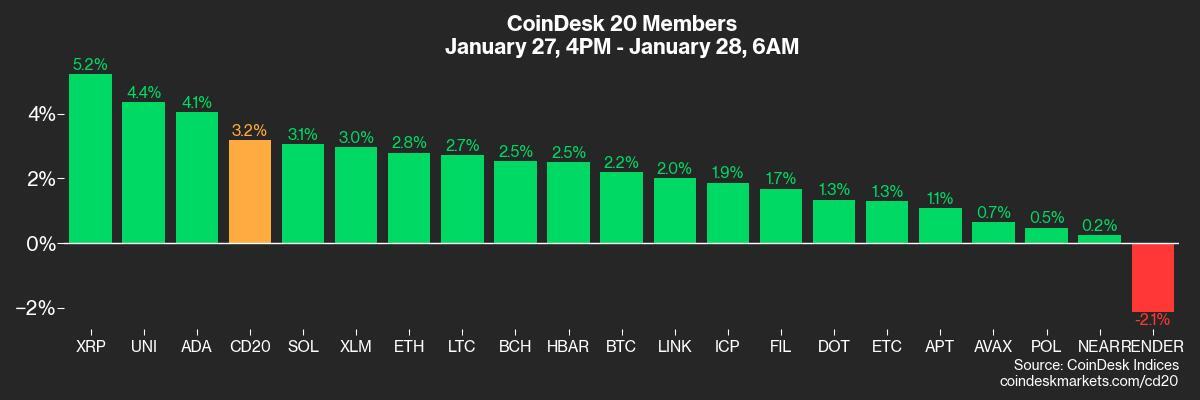
DXY is up 0.57% at 107.95
Gold is up 0.34% at $2,743.59/oz
Silver is up 0.35% to $30.16/oz
Nikkei 225 closed -1.39% at 39,016.87
Hang Seng closed +0.14% to 20,225.11
FTSE is up 0.58% at 8,553.75
Euro Stoxx 50 is up 0.47% at 5,212.71
DJIA closed on Monday +0.65% to 44,713.58
S&P 500 closed -1.46% at 6,012.28
Nasdaq closed -3.07% at 19,341.83
S&P/TSX Composite Index closed -0.7% at 25,289.15
S&P 40 Latin America closed +0.34% at 2,330.61
U.S. 10-year Treasury is up 3 bps at 4.57%
E-mini S&P 500 futures are up 0.39% at 6070.50
E-mini Nasdaq-100 futures are up 0.67% at 21,400.25
E-mini Dow Jones Industrial Average Index futures are unchanged at 44,935.00
Bitcoin Stats:
BTC Dominance: 59.16 (0.15%)
Ethereum to bitcoin ratio: 0.031 (-0.32%)
Hashrate (seven-day moving average): 767 EH/s
Hashprice (spot): $58.7
Total Fees: 6.13 BTC/ $616,619
CME Futures Open Interest: 170,240 BTC
BTC priced in gold: 37.6 oz
BTC vs gold market cap: 10.68%
Technical Analysis
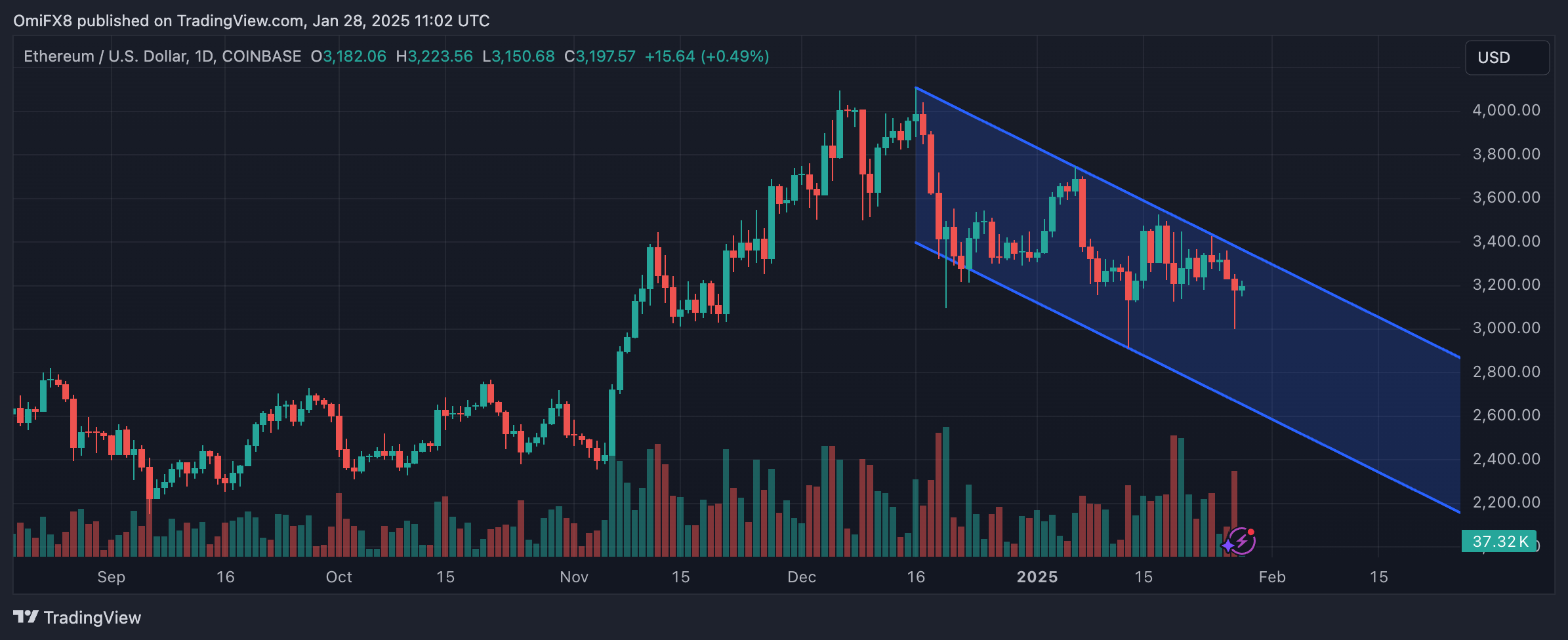
ETH carved out a candle with a long tail Monday, signaling bear fatigue at intraday lows. That’s often seen as a sign of an impending trend change higher.
Prices, however, remain trapped in a descending channel, suggesting a bearish outlook.
Crypto Equities
MicroStrategy (MSTR): closed on Monday at $347.92 (-1.63%), down 0.36% at $346.66 in pre-market.
Coinbase Global (COIN): closed at $277.99 (-6.71%), up 0.76% at $280.11 in pre-market.
Galaxy Digital Holdings (GLXY): closed at C$27.36 (-15.87%).
MARA Holdings (MARA): closed at $18.28 (-8.53%), up 0.63% at $18.40 in pre-market.
Riot Platforms (RIOT): closed at $11.45 (-15.44%), down 6.87% at $12.61 in pre-market.
Core Scientific (CORZ): closed at $11.28 (-29.41%), up 2.22% at $11.53 in pre-market.
CleanSpark (CLSK): closed at $10.31 (-10.62%), up 1.21% at $10.43 in pre-market.
CoinShares Valkyrie Bitcoin Miners ETF (WGMI): closed at $20.78 (-20.75%), down 3.99% at $21.61 in pre-market.
Semler Scientific (SMLR): closed at $50.43 (-9.07%).
Exodus Movement (EXOD): closed at $74 (+20.82%), unchanged in pre-market.
ETF Flows
ETF Flows
Spot BTC ETFs:
Daily net flow: -$457.6 million
Cumulative net flows: $39.49 billion
Total BTC holdings ~ 1.157 million.
Spot ETH ETFs
Daily net flow: -$136.2 million
Cumulative net flows: $2.67 billion
Total ETH holdings ~ 3.59 million.
Source: Farside Investors
Overnight Flows
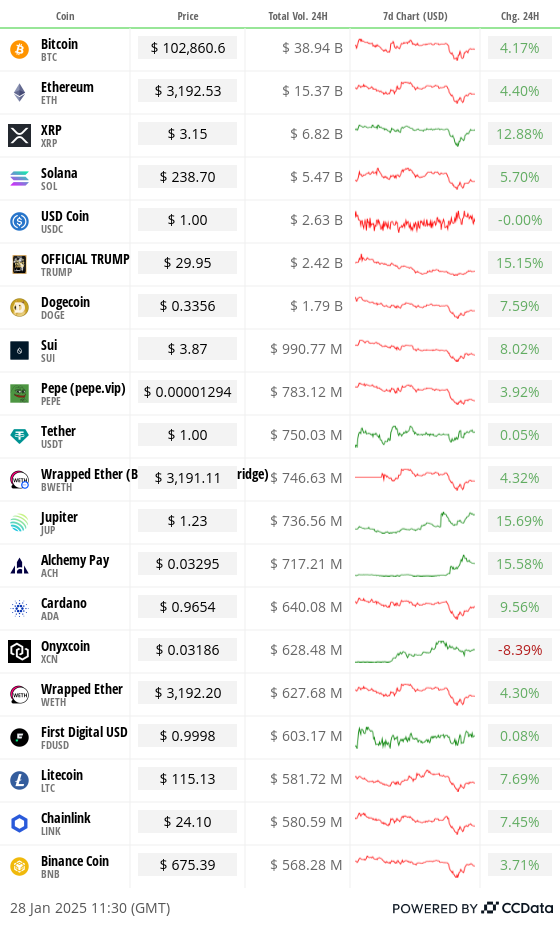
Chart of the Day
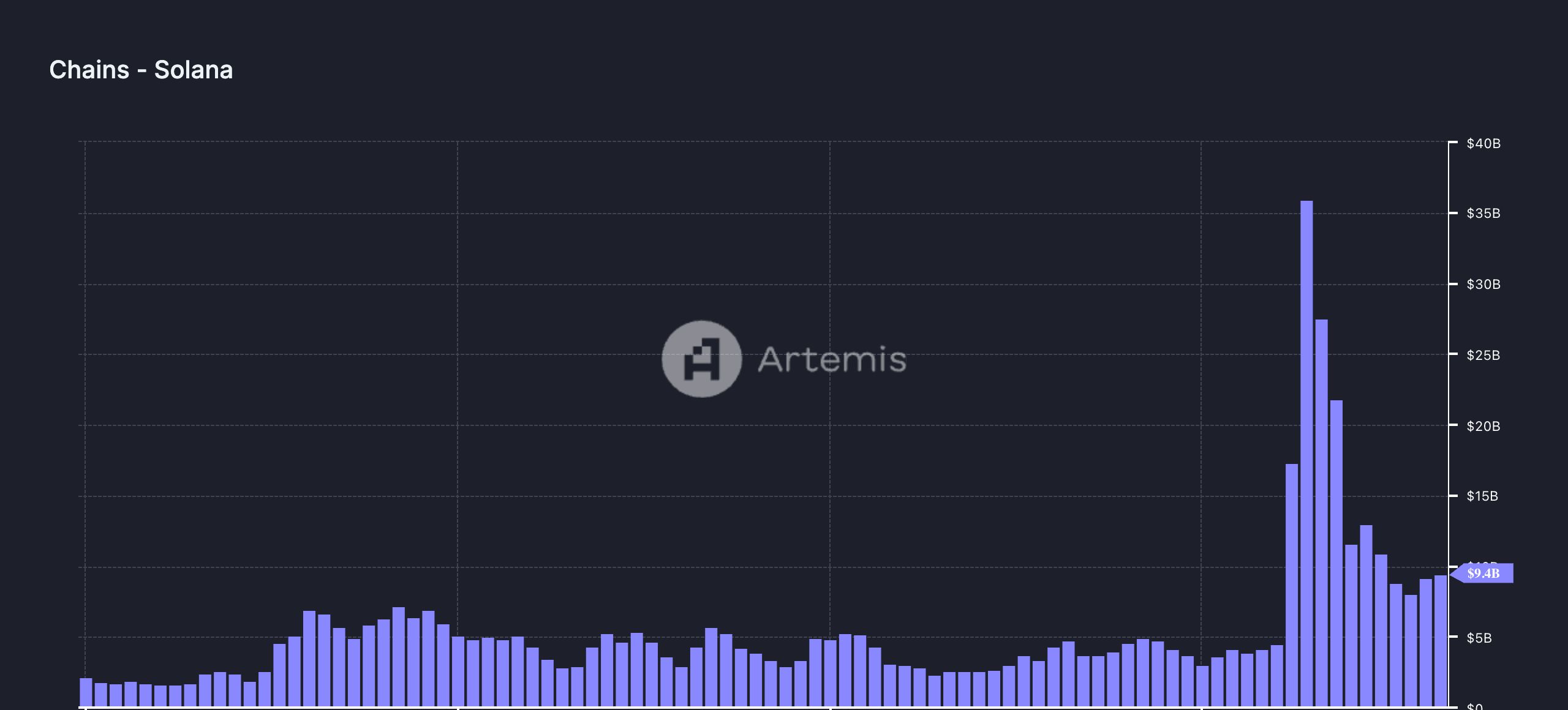
Daily trading volume on Solana-based decentralized exchanges has dropped sharply to less than $10 billon from the high of $35 billion registered on Jan. 18, when the TRUMP token debuted and triggered a memecoin frenzy.
Volumes, however, remain elevated at the average activity levels seen in November and December.
While You Were Sleeping
KuCoin to Pay Nearly $300M Fine After Pleading Guilty to DOJ Charges (CoinDesk): Crypto exchange KuCoin pleaded guilty to operating an unlicensed money-transmitting business, agreeing to pay $297 million in penalties and to exit the U.S. for two years.
Tuttle Capital Proposes First-Ever Leveraged ETFs of TRUMP, MELANIA, Cardano, Others (CoinDesk): Tuttle Capital Management filed 10 2x leveraged crypto ETF proposals with the SEC, including those tracking TRUMP and MELANIA memecoins.
Mad Money’s Jim Cramer Says ‘Own Bitcoin, Not MicroStrategy’ (CoinDesk): On Monday’s Mad Money, Jim Cramer endorsed owning bitcoin while cautioning against MicroStrategy, the largest corporate bitcoin holder. Critics frequently interpret his advice as a contrarian indicator.
Ripple’s CEO Brad Garlinghouse Bats for Diversified U.S. Crypto Reserve (CoinDesk): Ripple CEO Brad Garlinghouse supports a U.S. digital asset reserve representing multiple tokens, not just bitcoin, calling BTC maximalism «the enemy of crypto progress.»
BOJ to Raise Rates Again by July, Eventually Eye Hike to 1.5%, Says Ex-Policymaker (Reuters): Former Bank of Japan board member Makoto Sakurai predicts the bank will raise interest rates again by mid-2025, targeting 1.5% within two years.
Dollar Climbs as Trump Puts Tariff Threats Back on the Agenda (Bloomberg): The dollar strengthened against major currencies, with the yen leading losses after falling over 0.9%, as President Trump and Treasury Secretary Scott Bessent reignited tariff concerns.
OpenAI’s Altman Vows ‘Better Models’ as China’s DeepSeek Disrupts Global Race (Financial Times): On Monday, OpenAI CEO Sam Altman responded to DeepSeek’s generative AI rival to ChatGPT by pledging to accelerate product launches and deliver superior models.
In the Ether
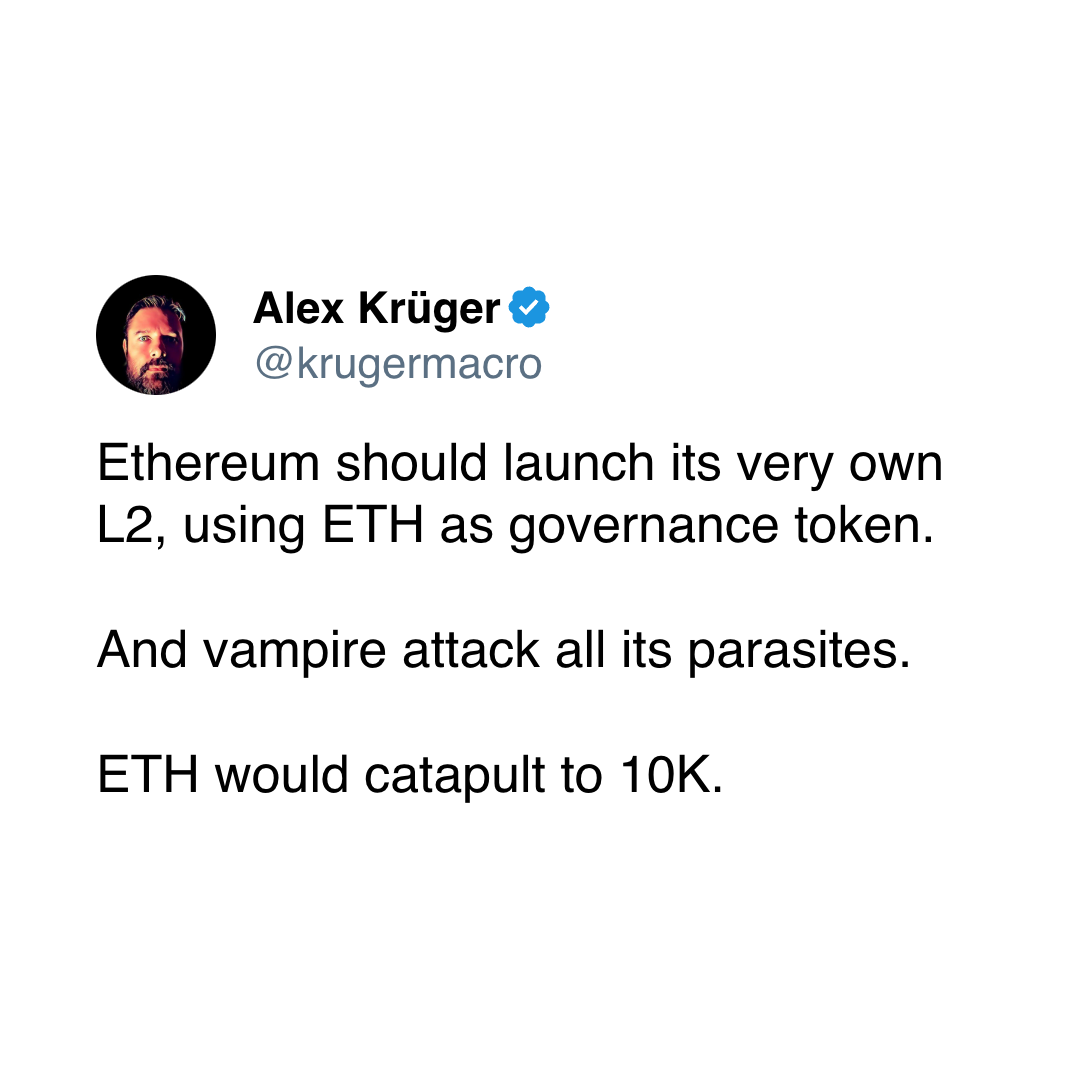
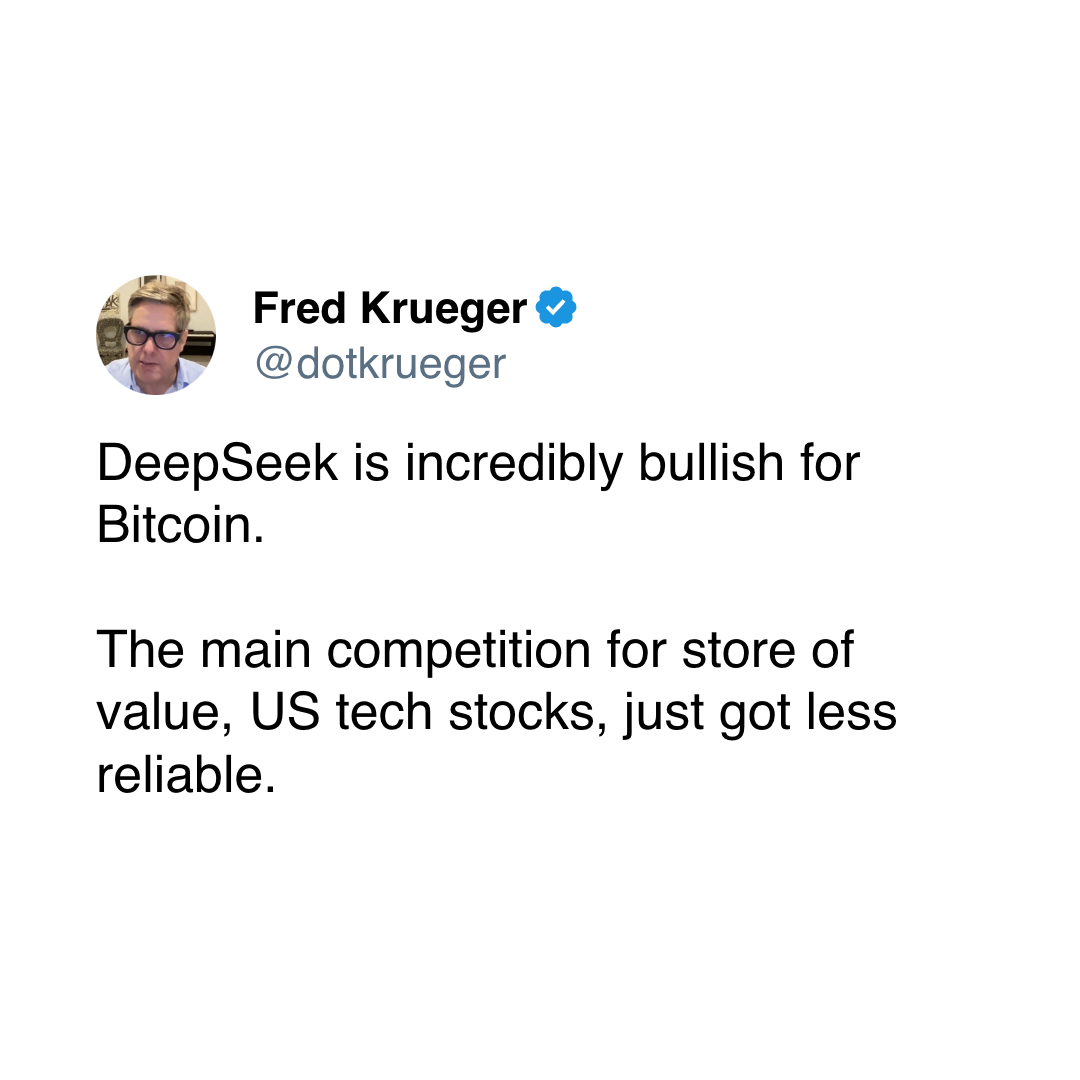
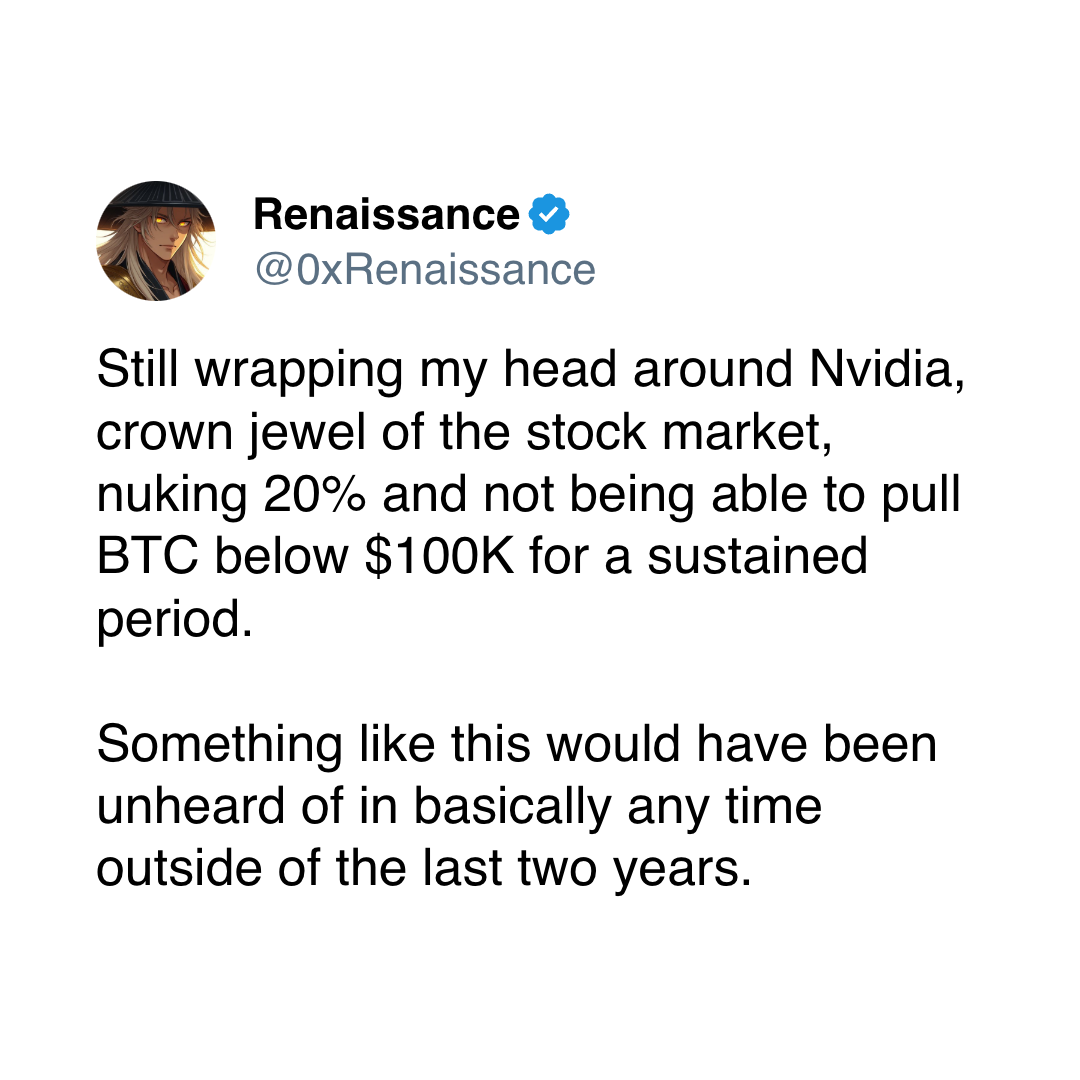

Uncategorized
BitMEX Co-Founder Arthur Hayes Sees Money Printing Extending Crypto Cycle Well Into 2026

Arthur Hayes believes the current crypto bull market has further to run, supported by global monetary trends he sees as only in their early stages.
Speaking in a recent interview with Kyle Chassé, a longtime bitcoin and Web3 entrepreneur, the BitMEX co-founder and current Maelstrom CIO argued that governments around the world are far from finished with aggressive monetary expansion.
He pointed to U.S. politics in particular, saying that President Donald Trump’s second term has not yet fully unleashed the spending programs that could arrive from mid-2026 onward. Hayes suggested that if expectations for money printing become extreme, he may consider taking partial profits, but for now he sees investors underestimating the scale of liquidity that could flow into equities and crypto.
Hayes tied his outlook to broader geopolitical shifts, including what he described as the erosion of a unipolar world order. In his view, such periods of instability tend to push policymakers toward fiscal stimulus and central bank easing as tools to keep citizens and markets calm.
He also raised the possibility of strains within Europe — even hinting that a French default could destabilize the euro — as another factor likely to accelerate global printing presses. While he acknowledged these policies eventually risk ending badly, he argued that the blow-off top of the cycle is still ahead.
Turning to bitcoin, Hayes pushed back on concerns that the asset has stalled after reaching a record $124,000 in mid-August.
He contrasted its performance with other asset classes, noting that while U.S. stocks are higher in dollar terms, they have not fully recovered relative to gold since the 2008 financial crisis. Hayes pointed out that real estate also lags when measured against gold, and only a handful of U.S. technology giants have consistently outperformed.
When measured against bitcoin, however, he believes all traditional benchmarks appear weak.
Hayes’ message was that bitcoin’s dominance becomes even clearer once assets are viewed through the lens of currency debasement.
For those frustrated that bitcoin is not posting fresh highs every week, Hayes suggested that expectations are misplaced.
In his telling, investors from the traditional world and those in crypto actually share the same premise: governments and central banks will print money whenever growth falters. Hayes says traditional finance tends to express this view by buying bonds on leverage, while crypto investors hold bitcoin as the “faster horse.”
His conclusion is that patience is essential. Hayes argued that the real edge of holding bitcoin comes from years of compounding outperformance rather than short-term speculation.
Coupled with what he sees as an inevitable wave of money creation through the rest of the decade, he believes the present crypto cycle could stretch well into 2026, far from exhausted.
Uncategorized
Bitcoin Bulls Bet on Fed Rate Cuts To Drive Bond Yields Lower, But There’s a Catch
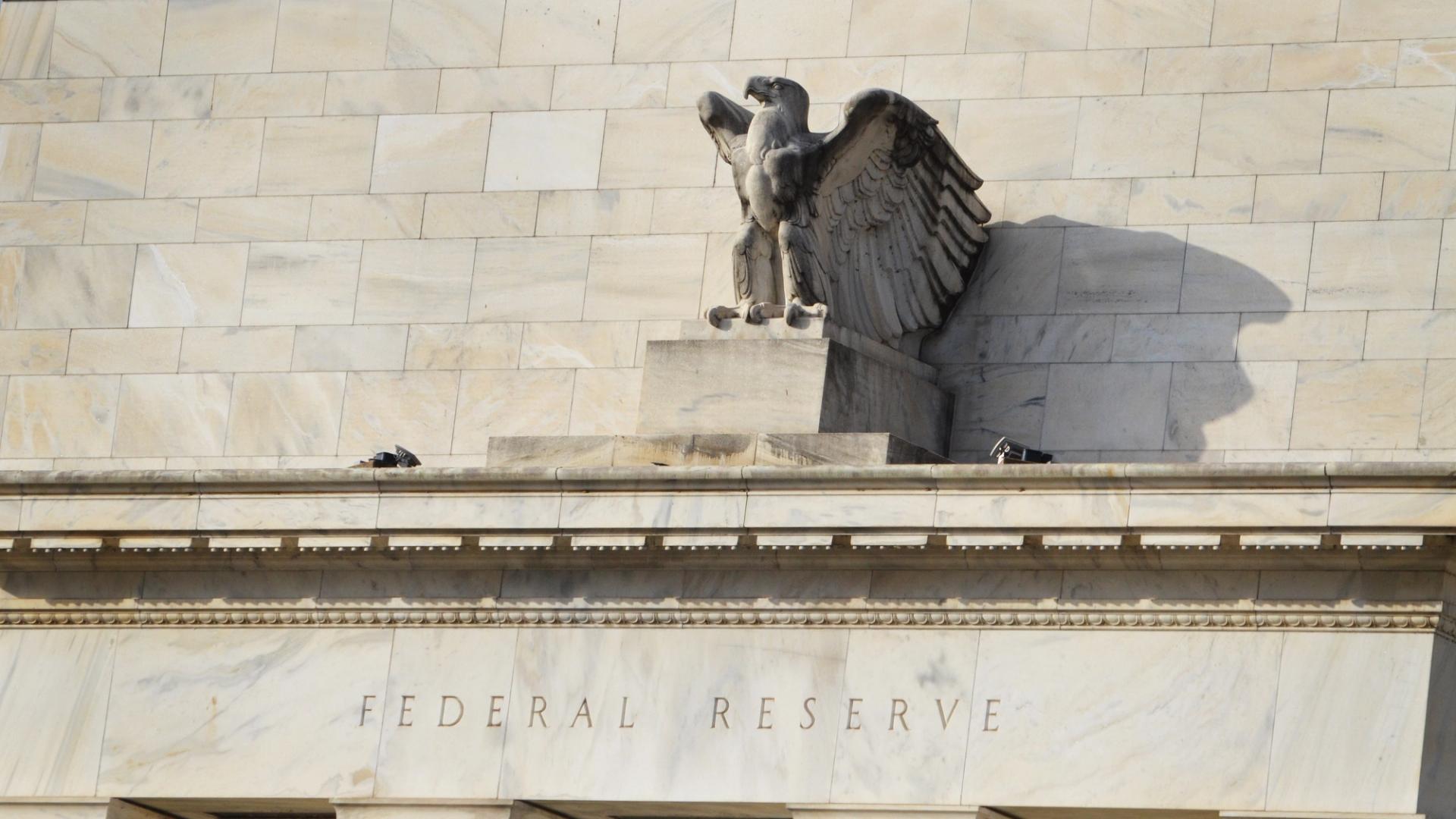
On Sept. 17, the U.S. Federal Reserve (Fed) is widely expected to cut interest rates by 25 basis points, lowering the benchmark range to 4.00%-4.25%. This move will likely be followed by more easing in the coming months, taking the rates down to around 3% within the next 12 months. The fed funds futures market is discounting a drop in the fed funds rate to less than 3% by the end of 2026.
Bitcoin (BTC) bulls are optimistic that the anticipated easing will push Treasury yields sharply lower, thereby encouraging increased risk-taking across both the economy and financial markets. However, the dynamics are more complex and could lead to outcomes that differ significantly from what is anticipated.
While the expected Fed rate cuts could weigh on the two-year Treasury yield, those at the long end of the curve may remain elevated due to fiscal concerns and sticky inflation.
Debt supply
The U.S. government is expected to increase the issuance of Treasury bills (short-term instruments) and eventually longer-duration Treasury notes to finance the Trump administration’s recently approved package of extended tax cuts and increased defense spending. According to the Congressional Budget Office, these policies are likely to add over $2.4 trillion to primary deficits over ten years, while Increasing debt by nearly $3 trillion, or roughly $5 trillion if made permanent.
The increased supply of debt will likely weigh on bond prices and lift yields. (bond prices and yields move in the opposite direction).
«The U.S. Treasury’s eventual move to issue more notes and bonds will pressure longer-term yields higher,» analysts at T. Rowe Price, a global investment management firm, said in a recent report.
Fiscal concerns have already permeated the longer-duration Treasury notes, where investors are demanding higher yields to lend money to the government for 10 years or more, known as the term premium.
The ongoing steepening of the yield curve – which is reflected in the widening spread between 10- and 2-year yields, as well as 30- and 5-year yields and driven primarily by the relative resilience of long-term rates – also signals increasing concerns about fiscal policy.
Kathy Jones, managing director and chief income strategist at the Schwab Center for Financial Research, voiced a similar opinion this month, noting that «investors are demanding a higher yield for long-term Treasuries to compensate for the risk of inflation and/or depreciation of the dollar as a consequence of high debt levels.»
These concerns could keep long-term bond yields from falling much, Jones added.
Stubborn inflation
Since the Fed began cutting rates last September, the U.S. labor market has shown signs of significant weakening, bolstering expectations for a quicker pace of Fed rate cuts and a decline in Treasury yields. However, inflation has recently edged higher, complicating that outlook.
When the Fed cut rates in September last year, the year-on-year inflation rate was 2.4%. Last month, it stood at 2.9%, the highest since January’s 3% reading. In other words, inflation has regained momentum, weakening the case for faster Fed rate cuts and a drop in Treasury yields.
Easing priced in?
Yields have already come under pressure, likely reflecting the market’s anticipation of Federal Reserve rate cuts.
The 10-year yield slipped to 4% last week, hitting the lowest since April 8, according to data source TradingView. The benchmark yield has dropped over 60 basis points from its May high of 4.62%.
According to Padhraic Garvey, CFA, regional head of research, Americas at ING, the drop to 4% is likely an overshoot to the downside.
«We can see the 10yr Treasury yield targeting still lower as an attack on 4% is successful. But that’s likely an overshoot to the downside. Higher inflation prints in the coming months will likely cause long-end yields some issues, requiring a significant adjustment,» Garvey said in a note to clients last week.
Perhaps rate cuts have been priced in, and yields could bounce back hard following the Sept. 17 move, in a repeat of the 2024 pattern. The dollar index suggests the same, as noted early this week.
Lesson from 2024
The 10-year yield fell by over 100 basis points to 3.60% in roughly five months leading up to the September 2024 rate cut.
The central bank delivered additional rate cuts in November and December. Yet, the 10-year yield bottomed out with the September move and rose to 4.57% by year-end, eventually reaching a high of 4.80% in January of this year.
According to ING, the upswing in yields following the easing was driven by economic resilience, sticky inflation, and fiscal concerns.
As of today, while the economy has weakened, inflation and fiscal concerns have worsened as discussed earlier, which means the 2024 pattern could repeat itself.
What it means for BTC?
While BTC rallied from $70,000 to over $100,000 between October and December 2024 despite rising long-term yields, this surge was primarily fueled by optimism around pro-crypto regulatory policies under President Trump and growing corporate adoption of BTC and other tokens.
However, these supporting narratives have significantly weakened looking back a year later. Consequently, the possibility of a potential hardening of yields in the coming months weighing over bitcoin cannot be dismissed.
Read: Here Are the 3 Things That Could Spoil Bitcoin’s Rally Towards $120K
Uncategorized
Are the Record Flows for Traditional and Crypto ETFs Reducing the Power of the Fed?

Record-breaking flows into exchange-traded funds may be reshaping markets in ways that even the Federal Reserve can’t control.
New data show U.S.-listed ETFs have become a dominant force in capital markets. According to a Friday press release by ETFGI, an independent consultancy, assets invested in U.S. ETFs hit a record $12.19 trillion at the end of August, up from $10.35 trillion at the close of 2024. Bloomberg, which highlighted the surge on Friday, noted the flows are challenging the traditional influence of the Federal Reserve.
Investors poured $120.65 billion into ETFs during August alone, lifting year-to-date inflows to $799 billion — the highest on record. By comparison, the prior full-year record was $643 billion in 2024.
The growth is concentrated among the biggest providers. iShares leads with $3.64 trillion in assets, followed closely by Vanguard with $3.52 trillion and State Street’s SPDR family at $1.68 trillion.
Together, those three firms control nearly three-quarters of the U.S. ETF market. Equity ETFs drew the largest share of August inflows at $42 billion, while fixed-income funds added $32 billion and commodity ETFs nearly $5 billion.
Crypto-linked ETFs are now a meaningful piece of the picture.
Data from SoSoValue show U.S.-listed spot bitcoin and ether ETFs manage more than $120 billion combined, led by BlackRock’s iShares Bitcoin Trust (IBIT) and Fidelity’s Wise Origin Bitcoin Trust (FBTC). Bitcoin ETFs alone account for more than $100 billion, equal to about 4% of bitcoin’s $2.1 trillion market cap. Ether ETFs add another $20 billion, despite launching only earlier this year.
The surge underscores how ETFs — traditional and crypto alike — have become the vehicle of choice for investors of all sizes. For many, the flows are automatic.
In the U.S., much of the cash comes from retirement accounts known as 401(k)s, where workers put aside part of every paycheck.
A growing share of that money goes into “target-date funds.” These funds automatically shift investments — moving gradually from stocks into bonds — as savers approach retirement age. Model portfolios and robo-advisers follow similar rules, automatically directing flows into ETFs without investors making day-to-day choices.
Bloomberg described this as an “autopilot” effect: every two weeks, millions of workers’ contributions are funneled into index funds that buy the same baskets of stocks, regardless of valuations, headlines or Fed policy. Analysts cited by Bloomberg say this steady demand helps explain why U.S. equity indexes keep climbing even as data on jobs and inflation show signs of strain.
The trend raises questions about the Fed’s influence.
Traditionally, interest rate cuts or hikes sent strong signals that rippled through stocks, bonds, and commodities. Lower rates typically encouraged risk-taking, while higher rates reined it in. But with ETFs absorbing hundreds of billions of dollars on a set schedule, markets may be less sensitive to central bank cues.
That tension is especially clear this month. With the Fed expected to cut rates by a quarter point on Sept. 17, stocks sit near record highs and gold trades above $3,600 an ounce.
Bitcoin, meanwhile, is trading at around $116,000, not far from its all-time high of $124,000 set in mid August.
Stock, bond and crypto ETFs have seen strong inflows, suggesting investors are positioning for easier money — but also reflecting a structural tide of passive allocations.
Supporters told Bloomberg the rise of ETFs has lowered costs and broadened access to markets. But critics quoted in the same report warn that the sheer scale of inflows could amplify volatility if redemptions cluster in a downturn, since ETFs move whole baskets of securities at once.
As Bloomberg put it, this “perpetual machine” of passive investing may be reshaping markets in ways that even the central bank struggles to counter.
-

 Business11 месяцев ago
Business11 месяцев ago3 Ways to make your business presentation more relatable
-

 Fashion11 месяцев ago
Fashion11 месяцев agoAccording to Dior Couture, this taboo fashion accessory is back
-

 Entertainment11 месяцев ago
Entertainment11 месяцев ago10 Artists who retired from music and made a comeback
-

 Entertainment11 месяцев ago
Entertainment11 месяцев ago\’Better Call Saul\’ has been renewed for a fourth season
-

 Entertainment11 месяцев ago
Entertainment11 месяцев agoNew Season 8 Walking Dead trailer flashes forward in time
-

 Business11 месяцев ago
Business11 месяцев ago15 Habits that could be hurting your business relationships
-

 Entertainment11 месяцев ago
Entertainment11 месяцев agoMeet Superman\’s grandfather in new trailer for Krypton
-

 Entertainment11 месяцев ago
Entertainment11 месяцев agoDisney\’s live-action Aladdin finally finds its stars






www.binance.com
6 сентября, 2025 at 4:54 пп
Your point of view caught my eye and was very interesting. Thanks. I have a question for you. https://www.binance.info/ru-UA/register?ref=OMM3XK51
registro na binance us
7 сентября, 2025 at 9:35 пп
Thanks for sharing. I read many of your blog posts, cool, your blog is very good.